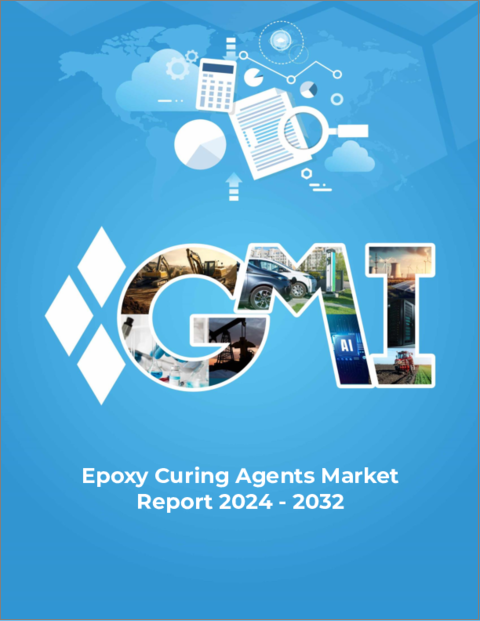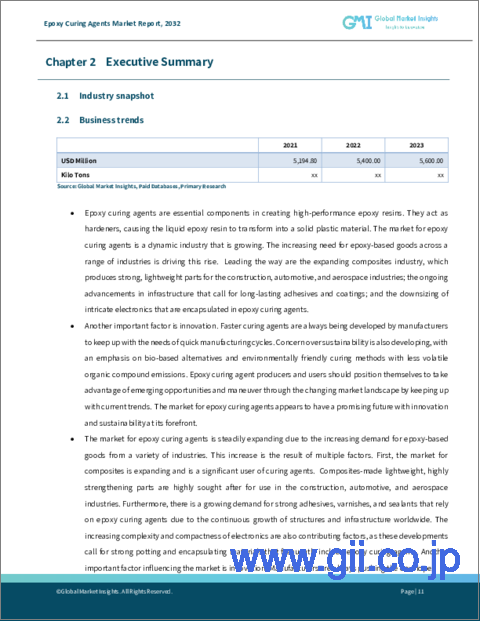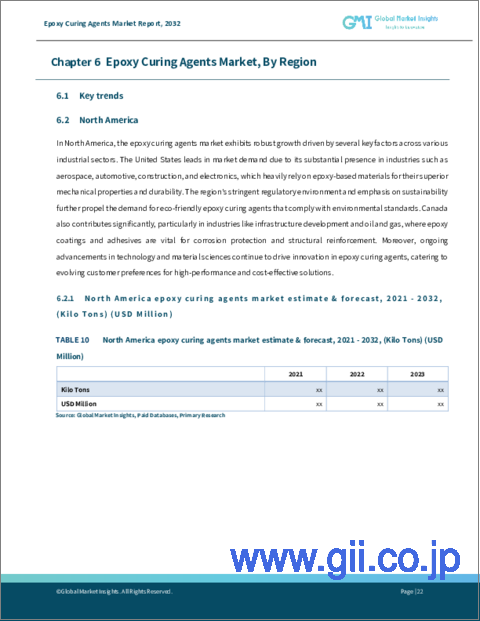|
|
市場調査レポート
商品コード
1516037
エポキシ硬化剤市場:樹脂タイプ別、用途別、エンドユーザー別、予測、2024年~2032年Epoxy Curing Agents Market - By Resin Type (Amines, Polyamides, Anhydride), By Application (Composites, Paints & Coatings, Adhesives, Sealants, & Electronic Encapsulation), By End User & Forecast, 2024 - 2032 |
||||||
カスタマイズ可能
|
|||||||
| エポキシ硬化剤市場:樹脂タイプ別、用途別、エンドユーザー別、予測、2024年~2032年 |
|
出版日: 2024年04月01日
発行: Global Market Insights Inc.
ページ情報: 英文 200 Pages
納期: 2~3営業日
|
- 全表示
- 概要
- 目次
世界のエポキシ硬化剤市場は、エポキシ硬化剤の絶え間ない技術革新と最終用途産業からの需要増に牽引され、2024年から2032年にかけてCAGR 6.9%で成長すると予想されます。
自動車、建設、エレクトロニクス、航空宇宙産業では、硬化時間の短縮、接着強度の強化、化学薬品に対する耐性の向上など、関連する機能強化を求める傾向が強まっており、こうした機能強化によって変化するニーズを満たすことができ、この分野の成長に拍車がかかっています。
例えば、Evonikは2024年4月、急速硬化と耐紫外線性で有名な新規エポキシ硬化剤Ancamine(R)2880を発表しました。この革新的な製品は、機械的特性、色安定性、耐摩耗性に優れており、使用寿命も長いです。この開発は、エポキシベースの塗料や材料に依存する様々な業界から大きな注目を集め、同様の高性能エポキシ硬化剤の需要を世界的に煽る可能性があります。
エポキシ硬化剤業界は、樹脂タイプ、用途、エンドユーザー、地域によって細分化されています。
ポリアミドは機械的特性、耐薬品性、エポキシ樹脂との相溶性に優れているため、さまざまな産業で広く使用されています。さらに、ポリアミドは卓越した耐熱性や迅速な硬化速度などの利点を備えているため、迅速な生産サイクルと卓越した性能を必要とする用途に適した選択肢となり、市場シェア拡大の原動力となっています。
塗料・コーティングセグメントのエポキシ硬化剤市場は、自動車、建築、工業などさまざまな分野のコーティング剤配合におけるエポキシ硬化剤の広範な利用によって、2032年までに顕著な急成長が見られると思われます。エポキシ硬化剤は、塗料の接着性、耐久性、耐薬品性を高める上で重要な役割を果たしており、保護と装飾の両方の目的で不可欠なものとなっています。さらに、これらの産業が世界中で持続的に拡大していることが、このセグメントの市場での存在感を高めています。
アジア太平洋地域のエポキシ硬化剤産業は、2024年から2032年にかけて、建設、自動車、エレクトロニクス産業の隆盛に後押しされ、大幅なCAGRを経験すると思われます。インフラ整備の進展、都市化の進展、さまざまな産業分野への投資の活発化が、アジア太平洋地域におけるエポキシ硬化剤の堅調な需要に寄与しています。さらに、APAC地域の製造能力と拡大する消費者市場は、エポキシ硬化剤市場展望の成長への主要貢献者としての地位を強化すると思われます。
目次
第1章 調査手法と調査範囲
第2章 エグゼクティブサマリー
第3章 エポキシ硬化剤業界考察
- エコシステム分析
- バリューチェーン
- 主要メーカー
- 市場参入ルート
- 主要流通業者
- 新しい流通チャネル
- 業界全体の利益率
- 業界への影響要因
- 促進要因
- 市場の課題
- 市場機会
- 新市場/用途
- 成長可能性分析
- 原材料情勢
- 製造動向
- 技術の進化
- 持続可能な製造
- グリーンプラクティス
- 脱炭素化
- 新原料
- 原材料価格動向(米ドル/トン)
- 米国
- 欧州連合
- 英国
- 中国
- 東南アジア
- GCC
- 製造動向
- 規制と市場への影響
- 貿易統計
- アンメットニーズ
- ポーター分析
- PESTEL分析
第4章 競合情勢
- 企業シェア分析
- 競合のポジショニングマトリックス
- 戦略展望マトリックス
第5章 市場推定・予測:樹脂タイプ別、2018年~2032年
- 主要動向
- アミン
- ポリアミド
- 無水物
- その他
第6章 市場推定・予測:用途別、2018年~2032年
- 主要動向
- 複合材料
- 塗料・コーティング
- 接着剤
- シーラント
- 電子カプセル化
- その他
第7章 市場推定・予測:エンドユーザー別、2018年~2032年
- 主要動向
- 建築・建設
- 輸送
- 一般産業
- 風力発電
- 航空宇宙
- その他
第8章 市場推定・予測:地域別、2018年~2032年
- 主要動向:地域別
- 北米
- 米国
- カナダ
- 欧州
- ドイツ
- 英国
- フランス
- スペイン
- ポーランド
- イタリア
- ロシア
- アジア太平洋
- 中国
- インド
- 日本
- 韓国
- インドネシア
- オーストラリア
- マレーシア
- ラテンアメリカ
- ブラジル
- メキシコ
- 中東・アフリカ
- 南アフリカ
- サウジアラビア
- アラブ首長国連邦
第9章 企業プロファイル
- Atul Ltd.
- BASF SE
- Evonik Industries AG
- Huntsman International LLC
- Olin Corporation
- Shandong Deyuan Epoxy Resin Co., Ltd
- Solvay
- Toray Industries Inc.
- Westlake Corporation
Global epoxy curing agents market will grow at a CAGR of 6.9% from 2024 to 2032, driven by continuous innovation in epoxy curing agents and rising demand from the end-use industries. The automotive, construction, electronics, and aerospace industries are increasingly looking for quicker curing times, stronger adhesion strengths, and better resistance against chemicals, among other related enhancements, through which they can satisfy their changing needs, which are being fueled by this sector's growth.
For instance, in April 2024, Evonik introduced Ancamine(R) 2880, a novel epoxy curing agent renowned for its rapid curing and UV resistance. This innovative product boasts outstanding mechanical properties, color stability, and abrasion resistance over its operational lifespan. This development is likely to attract considerable attention from various industries relying on epoxy-based coatings and materials, potentially fueling demand for similar high-performance epoxy curing agents globally.
The epoxy curing agents industry is fragmented based on resin type, application, end user, and region.
The polyamide resin type segment will undergo a significant uptick through 2032, attributed to the widespread use of polyamides in various industries due to their excellent mechanical properties, chemical resistance, and compatibility with epoxy resins. Moreover, polyamides present benefits like exceptional heat resistance and quick curing rates, rendering them the favored option for applications necessitating swift production cycles and exceptional performance, thereby driving their market share expansion.
The epoxy curing agents market from the paints and coatings segment will see a notable surge by 2032, driven by the extensive utilization of epoxy curing agents in formulating coatings across various sectors such as automotive, construction, and industrial. Epoxy curing agents play a critical role in enhancing the adhesion, durability, and chemical resistance of coatings, making them indispensable for both protective and decorative purposes. Furthermore, the sustained expansion of these industries worldwide strengthens the segment's substantial market presence.
Asia Pacific epoxy curing agents industry will experience a substantial CAGR from 2024 to 2032, propelled by the region's thriving construction, automotive, and electronics industries. Growing infrastructural development, increasing urbanization, and heightened investments in various industrial sectors contribute to the robust demand for epoxy curing agents in Asia Pacific. Moreover, the manufacturing prowess and expanding consumer market in the APAC region will reinforce its position as the primary contributor to the growth of the epoxy curing agents market outlook.
Table of Contents
Chapter 1 Methodology & Scope
- 1.1 Market scope & definition
- 1.2 Base estimates & calculations
- 1.3 Forecast calculation
- 1.4 Data sources
- 1.4.1 Primary
- 1.4.2 Data mining sources
- 1.4.2.1 Paid sources
- 1.4.2.2 Public sources
Chapter 2 Executive Summary
- 2.1 Industry 360 degree synopsis, 2018 - 2032
Chapter 3 Epoxy Curing Agents Industry Insights
- 3.1 Industry ecosystem analysis
- 3.1.1 Value chain
- 3.1.2 Key manufacturers
- 3.1.3 Go to market routes
- 3.1.4 Key distributors
- 3.1.4.1 New distribution channels
- 3.1.5 Profit margins across the industry
- 3.2 Industry impact forces
- 3.2.1 Growth drivers
- 3.2.2 Market challenges
- 3.2.3 Market opportunities
- 3.2.3.1 New markets/applications
- 3.2.3.2 Growth potential analysis
- 3.3 Raw material landscape
- 3.3.1 Manufacturing trends
- 3.3.1.1 Technology evolution
- 3.3.1.2 Sustainable manufacturing
- 3.3.1.2.1 Green practices
- 3.3.1.2.2 Decarbonization
- 3.3.2 New raw materials
- 3.3.3 Raw material pricing trends (USD/Ton)
- 3.3.3.1 U.S.
- 3.3.3.2 European Union
- 3.3.3.3 UK
- 3.3.3.4 China
- 3.3.3.5 Southeast Asia
- 3.3.3.6 GCC
- 3.3.1 Manufacturing trends
- 3.4 Regulations & market impact
- 3.5 Trade statistics
- 3.6 Unmet needs
- 3.7 Porter's analysis
- 3.8 PESTEL analysis
Chapter 4 Competitive Landscape, 2023
- 4.1 Company market share analysis
- 4.2 Competitive positioning matrix
- 4.3 Strategic outlook matrix
Chapter 5 Market Estimates & Forecast, By Resin Type, 2018-2032 (USD Million) (Tons)
- 5.1 Key trends
- 5.2 Amines
- 5.3 Polyamides
- 5.4 Anhydride
- 5.5 Others
Chapter 6 Market Estimates & Forecast, By Application, 2018-2032 (USD Million) (Tons)
- 6.1 Key trends
- 6.2 Composites
- 6.3 Paints and coatings
- 6.4 Adhesives
- 6.5 Sealants
- 6.6 Electronic encapsulation
- 6.7 Others
Chapter 7 Market Estimates & Forecast, By End User, 2018-2032 (USD Million) (Tons)
- 7.1 Key trends
- 7.2 Building & construction
- 7.3 Transportation
- 7.4 General industry
- 7.5 Wind power
- 7.6 Aerospace
- 7.7 Others
Chapter 8 Market Estimates & Forecast, By Region, 2018-2032 (USD Million) (Tons)
- 8.1 Key trends, by region
- 8.2 North America
- 8.2.1 U.S.
- 8.2.2 Canada
- 8.3 Europe
- 8.3.1 Germany
- 8.3.2 UK
- 8.3.3 France
- 8.3.4 Spain
- 8.3.5 Poland
- 8.3.6 Italy
- 8.3.7 Russia
- 8.4 Asia Pacific
- 8.4.1 China
- 8.4.2 India
- 8.4.3 Japan
- 8.4.4 South Korea
- 8.4.5 Indonesia
- 8.4.6 Australia
- 8.4.7 Malaysia
- 8.5 Latin America
- 8.5.1 Brazil
- 8.5.2 Mexico
- 8.6 MEA
- 8.6.1 South Africa
- 8.6.2 Saudi Arabia
- 8.6.3 UAE
Chapter 9 Company Profiles
- 9.1 Atul Ltd.
- 9.2 BASF SE
- 9.3 Evonik Industries AG
- 9.4 Huntsman International LLC
- 9.5 Olin Corporation
- 9.6 Shandong Deyuan Epoxy Resin Co., Ltd
- 9.7 Solvay
- 9.8 Toray Industries Inc.
- 9.9 Westlake Corporation





